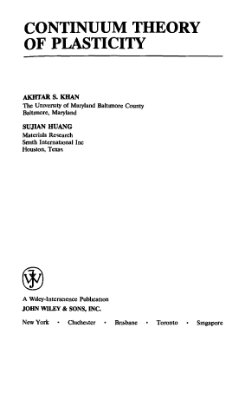Wiley-Interscience, 1995, 421 Pages
The only mode, up-to-date introduction to plasticity Despite phenomenal progress in plasticity research over the past fifty years, introductory books on plasticity have changed very little. To meet the need for an up-to-date introduction to the field, Akhtar S. Khan and Sujian Huang have written Continuum Theory of Plasticity-a truly mode text which offers a continuum mechanics approach as well as a lucid presentation of the essential classical contributions. The early chapters give the reader a review of elementary concepts of plasticity, the necessary background material on continuum mechanics, and a discussion of the classical theory of plasticity. Recent developments in the field are then explored in sections on the Mroz Multisurface model, the Dafalias and Popov Two Surface model, the non-linear kinematic hardening model, the endochronic theory of plasticity, and numerous topics in finite deformation plasticity theory and strain space formulation for plastic deformation. Final chapters introduce the fundamentals of the micromechanics of plastic deformation and the analytical coupling between deformation of individual crystals and macroscopic material response of the polycrystal aggregate. For graduate students and researchers in engineering mechanics, mechanical, civil, and aerospace engineering, Continuum Theory of Plasticity offers a mode, comprehensive introduction to the entire subject of plasticity.
Introduction
Strain and Stress
General Principles
Yield Criteria
Classical Theory of Plasticity
Recent Developments in Plasticity
Finite Plastic Deformation
Strain Space Formulations for Plastic Deformation
Introduction to Dislocation Theory
Plastic Deformation of Single Crystals
Polycrystal Plasticity Theory
The only mode, up-to-date introduction to plasticity Despite phenomenal progress in plasticity research over the past fifty years, introductory books on plasticity have changed very little. To meet the need for an up-to-date introduction to the field, Akhtar S. Khan and Sujian Huang have written Continuum Theory of Plasticity-a truly mode text which offers a continuum mechanics approach as well as a lucid presentation of the essential classical contributions. The early chapters give the reader a review of elementary concepts of plasticity, the necessary background material on continuum mechanics, and a discussion of the classical theory of plasticity. Recent developments in the field are then explored in sections on the Mroz Multisurface model, the Dafalias and Popov Two Surface model, the non-linear kinematic hardening model, the endochronic theory of plasticity, and numerous topics in finite deformation plasticity theory and strain space formulation for plastic deformation. Final chapters introduce the fundamentals of the micromechanics of plastic deformation and the analytical coupling between deformation of individual crystals and macroscopic material response of the polycrystal aggregate. For graduate students and researchers in engineering mechanics, mechanical, civil, and aerospace engineering, Continuum Theory of Plasticity offers a mode, comprehensive introduction to the entire subject of plasticity.
Introduction
Strain and Stress
General Principles
Yield Criteria
Classical Theory of Plasticity
Recent Developments in Plasticity
Finite Plastic Deformation
Strain Space Formulations for Plastic Deformation
Introduction to Dislocation Theory
Plastic Deformation of Single Crystals
Polycrystal Plasticity Theory

